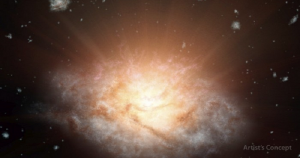
Astronomers Observe Most ‘Outrageously’ Luminous’ Galaxies Ever In The Universe
Astronomers at the University of Massachusetts (UMass) in Amherst report that they have observed the most luminous galaxies ever seen in the universe and that they are at a loss for words to describe them. Researchers said that established descriptors such as “ultra and hyper-luminous” used to describe previously brightest known galaxies do not even come close to describing the newly discovered objects.
The researchers had to invent a new category of their own to convey the actual level of brightness these galaxies can hit. “We’ve taken to calling them ‘outrageously luminous’ among ourselves because there is no scientific term to apply,” said Kevin Harrington from UMass, study’s lead author.
The astronomers made the find using Mexico’s 50-metre diameter Large Millimeter Telescope (LMT), latest generation of satellite telescope and data recorded by the European Space Agency’s Planck and Herschel space observatories. They estimate that the newly observed galaxies are about 10 billion years old, and are likely to have formed about 4 billion years after the Big Bang.
Harrington explained that in categorizing luminous sources, astronomers call an infrared galaxy “ultra-luminous” when it has a rating of about 1 trillion solar luminosities, and that rises to about 10 trillion solar luminosities at the “hyper-luminous” level. Beyond that, for the 100 trillion solar luminosities range of the new objects, “we don’t even have a name,” he said.
“The galaxies we found were not predicted by theory to exist; they’re too big and too bright, so no one really looked for them before,” said Professor Min Yun from the University of Massachusetts Amherst. “But now that we’re aware of them, it will help scientists to learn more about the conditions of the early Universe,” he added.
“Knowing that they really do exist and how much they have grown in the first 4 billion years since the Big Bang help us estimate how much material was there for them to work with.” said Yun. “Their existence teaches us about the process of collecting matter and of galaxy formation. They suggest that this process is more complex than many people thought.”
According to the scientists, the galaxies detected are not actually as large as they appear, as a phenomenon called gravitational lensing magnifies their light passing near massive objects, making them seem about 10 times brighter from Earth than they really are. Even so, they are impressive
“We still don’t know how many tens to hundreds of solar masses of gas can be converted into stars so efficiently in these objects,” said Harrington, “and studying these objects might help us to find out.”
The finding was published in the journal Monthly Notices of the Royal Astronomical Society.